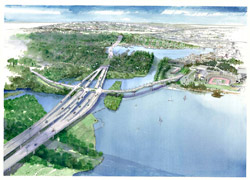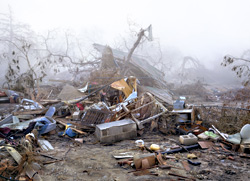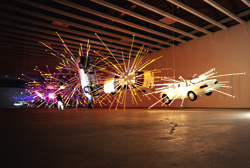Bundled like an amiable garden gnome, local artist Roy McMakin gamely stood at the bottom of the park in the muddy clay beside his incomplete sculpture, Love & Loss, awaiting the press. The words are spelled out in large letters. One “O” will be a reflecting pond, an actual split-trunk tree forms the “V,” while the rotating neon ampersand brightly imitates commercial Seattle signage. But the final “S” was missing, and there was no landscaping in sight. Construction workers still busily drove equipment along the unhewn terrain.
Nearby, also along the waterfront, the specially commissioned fountain by acclaimed French-American artist Louise Bourgeois, Father and Son, potentially one of the most powerful and unique elements of the park, was a mere concrete bowl, no controversial naked figures or water in view.
For the official press preview on Jan. 10, Seattle Art Museum’s long-awaited ambitious 8.5-acre waterfront Olympic Sculpture Park wasn’t finished. The wild winter surely slowed down the final landscaping and installation, but it was still a shame to be looking at mud and construction where two significant works should be.
But after numerous delays, the show had to go on. So swarms of media types from Toronto to Belltown braved the bitter chill to finally walk the half-mile Z path through the park.
And so . . . ?
First off, the park is rather stark. In part, of course, because it’s the middle of winter. No tree coverage, no wildflowers yet in the North Meadow. In summer, it’ll be a great spot to lie in the sun, but it needs more benches and more shade. Overall, the park could use more art—there are only 21 pieces by 16 artists, and a lot of space in between. Some of the pieces are disappointingly inaccessible—Claes Oldenburg and Coosje van Bruggen’s amusingly archaic Typewriter Eraser careens toward busy Elliott Avenue down a slope that makes for a dicey climb. And there’s certainly room for at least one piece of local Native American art.
I also find the Z too rigid. You’re somewhat obliged to follow the long zigzag of the path—no shortcuts and few diversions along the way. Co-designer Marion Weiss of Weiss/Manfredi coyly referred to the design as “a kind of striptease”—the park revealing itself in layers as you follow the unfurling Z—but it feels more like a maze that has only one way in and out.
Making this former Unocal wasteland—located in a part of town that doesn’t yet have much character or allure—into a destination is SAM’s biggest challenge.
It’s not yet obvious whether the park will be an oasis or an anomaly. It’s not exactly a peaceful place at the moment. There are lots of industrial noises—the clatter of trains, the rumble of trucks, creaking steel cranes. Trees need to grow to create a sound and visual barrier. At the moment, the park is more of a pause in the landscape between a surge of condos and the surging waters of the bay.
Having said all that, the park offers some fabulous art, great views, of course, and a few nicely defined spaces.
Richard Serra’s tremendous weathered steel Wake navigates a protected courtyard, making that corner one of the most successfully proportioned areas of the park. You feel both the immensity of Serra’s piece and yet an intimacy in the space. Another well-placed piece is Tony Smith’s Stinger, which nestles nicely in a bark-laden grove of trees. The geometric incomplete circle is large enough to contain sound and own the space, successfully creating a refuge. Teresita Fernandez’s glass bridge across the railway tracks, Seattle Cloud Cover, adds a needed splash of color and modern relief.
Like many art fans, I want this park to work. I think it’s an inspired idea, especially when you consider how valuable the land must be and what could have been built there instead. But I don’t think the general public should go there expecting it to be complete. Not yet. Even after SAM finds McMakin’s “S” and installs Bourgeois’ anguished, separated father and son. It will take years for this space to be realized, not just for the saplings to grow and offer a more tangible landscape, but for more art to join the space, and for the people who use it to define what it really will be. A place to sunbathe or fly a kite? A place to meditate or make out, as former curator Lisa Corrin suggested for McMakin’s bench? (You’ll need a pretty soft tush for that to be appealing; the thing is hard cement.) A place to experience art and the beauty of the Sound? Sure. And that’s not a bad place to start.
Sculpture Park Public Opening A two-day event with music, self-guided tours, etc. Western Avenue and Broad Street. See www.seattleartmuseum.org for info on free shuttles from various parts of town. Free. Sat., Jan. 20–Sun., Jan. 21. 11 a.m.–9 p.m.







